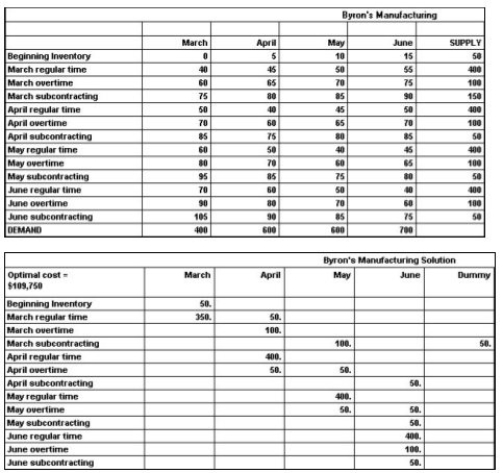Byron's Manufacturing makes tables.Demand for the next four months and capacities of the plant are shown in the table below.Unit cost on regular time is $40.Overtime cost is 150% of regular time cost.Subcontracting is available in substantial quantity at $75 per unit.Holding costs are $5 per table per month; back orders cost the firm $10 per unit per month.Byron's management believes that the transportation algorithm can be used to optimize this scheduling problem.The firm has 50 units of beginning inventory and anticipates no ending inventory.
 Answer the following questions based on the data table and solution table shown below.
Answer the following questions based on the data table and solution table shown below.  a.How many units will be produced on regular time in June?
a.How many units will be produced on regular time in June?
b.How many units will be produced by subcontracting over the four-month period?
c.What will be the inventory at the end of April?
d.What will be total production from all sources in April?
e.What will be the total cost of the optimum solution?
f.Does the firm utilize the expensive options of subcontracting and back ordering? When; why?
Definitions:
Simple Random Sample
A particular type of probability sample in which every member of the population has an equal chance of being selected.
Demographic Variables
Characteristics used to segment populations for study, such as age, gender, income, education, and ethnicity.
Equal Chance
The principle that all individuals should have the same opportunity to access resources, rights, and opportunities without discrimination.
Content Analysis
A research method used to interpret and analyze the content of various forms of media through coding and categorizing textual material.
Q3: What information is necessary for an operations
Q23: Orders are processed in the sequence in
Q24: _ is the minimum inventory necessary to
Q27: Groundz Coffee Shop uses 4 pounds of
Q29: Forward scheduling:<br>A)begins with a delivery date,then offsets
Q45: What does TPS stand for?<br>A)Total Production Streamlining<br>B)Toyota
Q51: DuLarge Marine manufactures diesel engines for shrimp
Q68: What is the trucking industry doing to
Q70: Amazon's original concept of operating without inventory
Q94: In the production order quantity model,the fraction